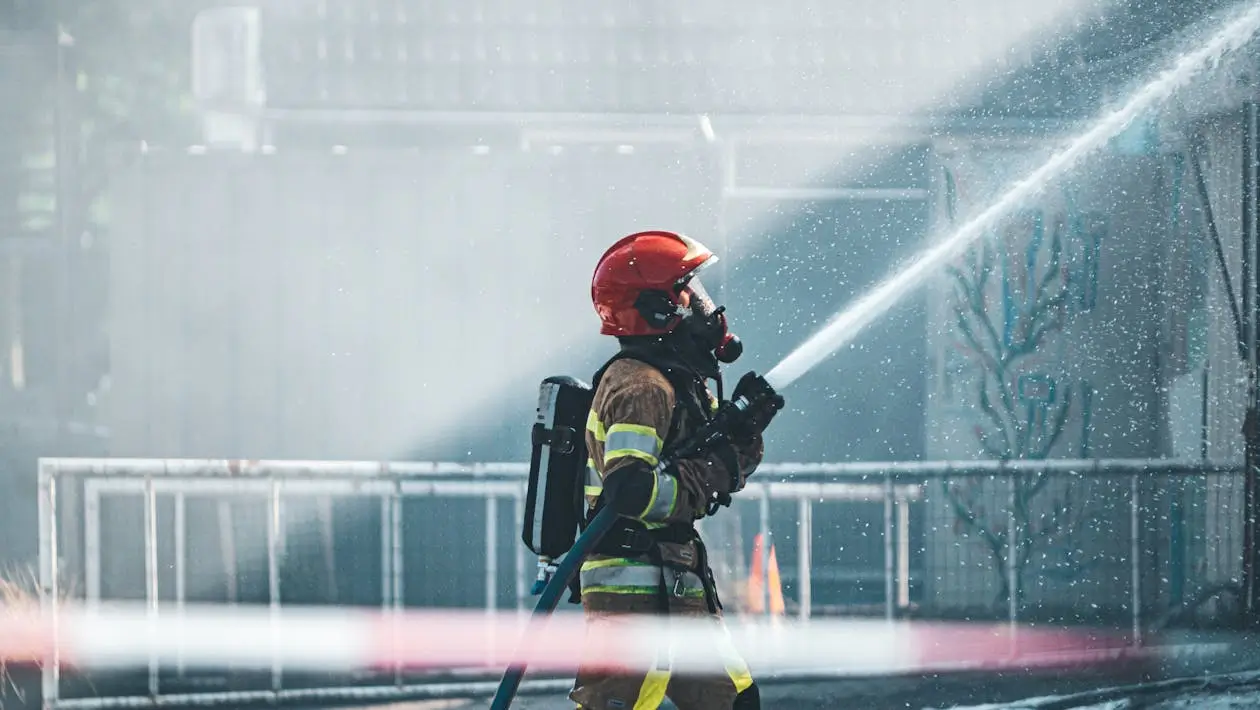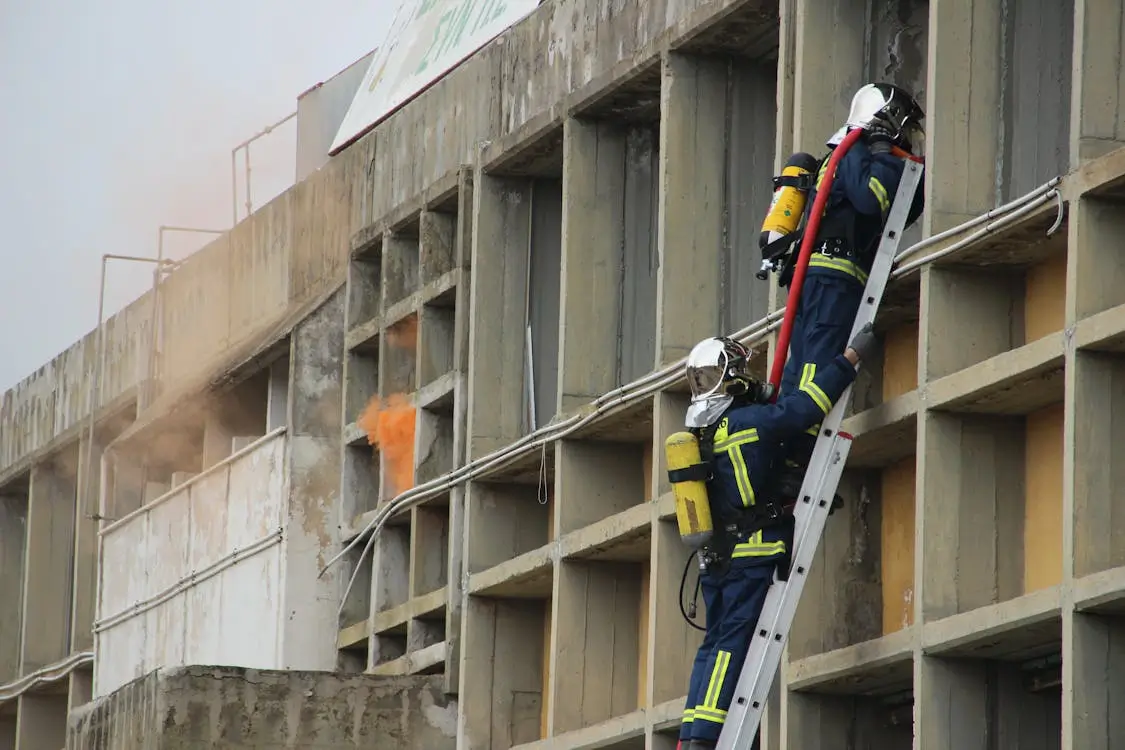This is a direct question, and I will give a direct answer before some supplementary information follows.
Question: To Safely Climb a Ladder, a Firefighter Should?
The firefighter needs to follow the ladder safety rule. It doesn’t matter who is climbing a ladder; the ladder safety rule is very clear. See the ladder safety rules in the next paragraph.
Ladder Safety Rules for Fire Fighters
1. Inspect Ladders Before Use: Before any operation, firefighters should thoroughly inspect ladders for defects such as cracks, bent rungs, loose bolts, or damaged locking mechanisms. A faulty ladder can collapse under load, causing serious injury or delaying rescue efforts. Inspections should also include checking the ladder’s cleanliness, as grease, soot, or ice can reduce grip and stability.
2. Ensure Proper Ladder Angle: A ladder must be positioned at the correct angle—generally a 4:1 ratio (for every 4 feet in height, place the base 1 foot away from the wall). This prevents the ladder from tipping backward or sliding out at the base. Proper angle placement ensures stability, reduces strain on the ladder, and makes climbing safer during urgent firefighting situations.
3. Secure the Ladder at Top and Bottom: Whenever possible, ladders should be tied off or secured at both the top and bottom. This prevents sudden movement caused by wind, hose water pressure, or shifting loads. Bottom securing avoids slippage, while top securing ensures the ladder remains steady when firefighters are climbing with heavy gear or carrying victims during rescue.
4. Maintain Three Points of Contact: Firefighters must always maintain three points of contact—two hands and one foot, or two feet and one hand—while climbing or descending. This minimizes the risk of losing balance and falling. Even during emergencies, tools should be carried using belts or rope hoists, keeping both hands free to grip the ladder securely.
5. Do Not Overload the Ladder: Every ladder has a maximum load capacity, which includes the weight of the firefighter, their gear, and any tools or victims being carried. Overloading can cause structural failure, especially under extreme heat during fire incidents. Knowing the ladder’s rated capacity and adhering to it is vital for maintaining safety and operational reliability.
6. Face the Ladder When Climbing: Firefighters should always face the ladder when ascending or descending. This position offers better balance, grip, and visibility of rungs, reducing the risk of slipping. Facing forward also allows quick reaction to sudden ladder shifts and helps maintain full control, especially when operating in wet, smoky, or debris-filled environments.
7. Avoid Sudden or Excessive Movement: Jerky, rushed, or excessive movements can destabilize the ladder, especially if it’s not fully secured. Firefighters should climb and work steadily, avoiding leaning too far to the sides. Any needed repositioning should involve moving the ladder entirely, rather than stretching dangerously beyond its safe reach, which could lead to tipping.
8. Keep Ladders Away from Electrical Hazards: Metal ladders, in particular, conduct electricity and can be deadly if they come into contact with live wires. Firefighters should always scan for overhead power lines or other electrical hazards before raising or moving a ladder. Using fiberglass ladders in electrical risk zones provides additional safety, especially in storm or rescue operations.
9. Set Ladders on Stable, Level Ground: The base of the ladder must be placed on firm, level ground. In firefighting, soft soil, wet grass, rubble, or ice can compromise stability. When the surface is uneven, use ladder levelers, wedges, or cribbing to ensure a solid footing. A steady base prevents tipping and keeps the ladder reliable during rescue or suppression tasks.
10. Retract and Store Ladders Safely: After use, ladders should be retracted, cleaned, and stored properly to maintain readiness. Removing soot, debris, and moisture prevents deterioration, while proper storage avoids bending or warping. A well-maintained ladder is always ready for the next emergency, ensuring that it performs optimally and safely when firefighters need it most.
Major Accidents Associated with the Use of Ladders
- Ladder Tipping Over: Inadequate placement or user error can cause a ladder to topple over, which is one of the most common ladder accidents. This frequently occurs when a person leans too much to one side or extends more than the ladder can support, throwing it off balance and sending it falling.
- Slipping on Rungs: Sliding on the ladder’s rungs is another frequent mishap, particularly when they’re greasy, damp, or slick with trash or other materials. The chance of sliding and falling off the ladder might be increased by wearing improper footwear or using reckless climbing techniques.
- Ladder Slipping: The ladder may slip or slide out of position if not properly secured, especially on uneven or unstable terrain, which could lead to collapse or loss of stability.
Conclusion
Every firefighter must follow ladder safety procedures when working from a ladder to stay safe. Although ladders were designed to ease the stress of working from an elevated position, they also have inherent risks that must be managed appropriately.
This is why anyone and everyone working from a ladder must follow safety precautions regardless of the type of job performed.
Related Posts
Step Ladder 3 Points Of Contact Rule: Why You Should Follow The Rule
10 Tips On The Safe Use Of a Step Ladder
Ladder Safety: 10 Precautions On The Use Of Ladders
Which of the following is not an Excavation Myth: 7 Key Facts
MEWP Safety: Safety Measures for Mobile Elevated Working Platform
23 Important Fall Safety Tips for the Workplace
11 Most Common Workplace Safety Mistakes to Look Out For
Who is a Rigger, and 21 Important Duties of a Rigger
A seasoned Health and Safety Consultant with over a decade of hands-on experience in Occupational Health and Safety, UBONG EDET brings unmatched expertise in health and safety management, hazard prevention, emergency response planning, and workplace risk control. With a strong passion for training and coaching, he has empowered professionals and organizations to build safer, more compliant work environments.
Certified in globally recognized programs including NEBOSH, ISO standards, and OSHA regulations, he combines technical know-how with practical strategies to drive health and safety excellence across industries. designing comprehensive HSE management systems or delivering impactful safety training, whether he] is committed to promoting a culture of safety and continuous improvement.


